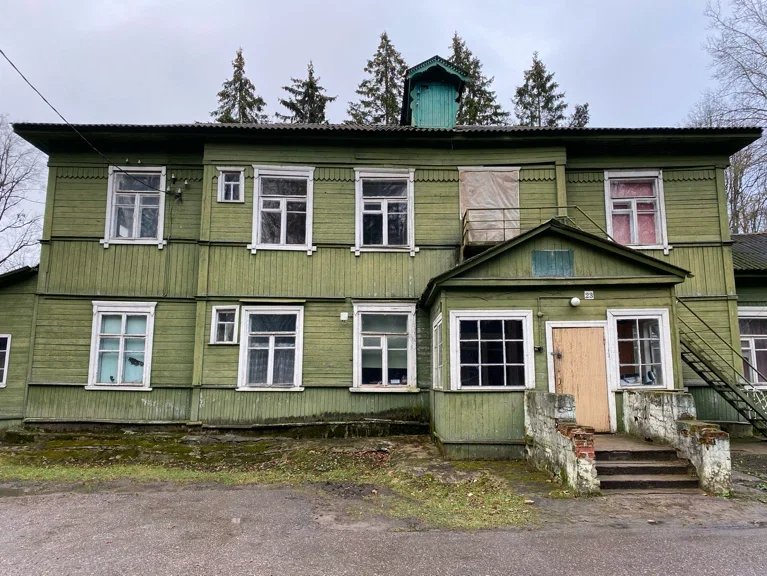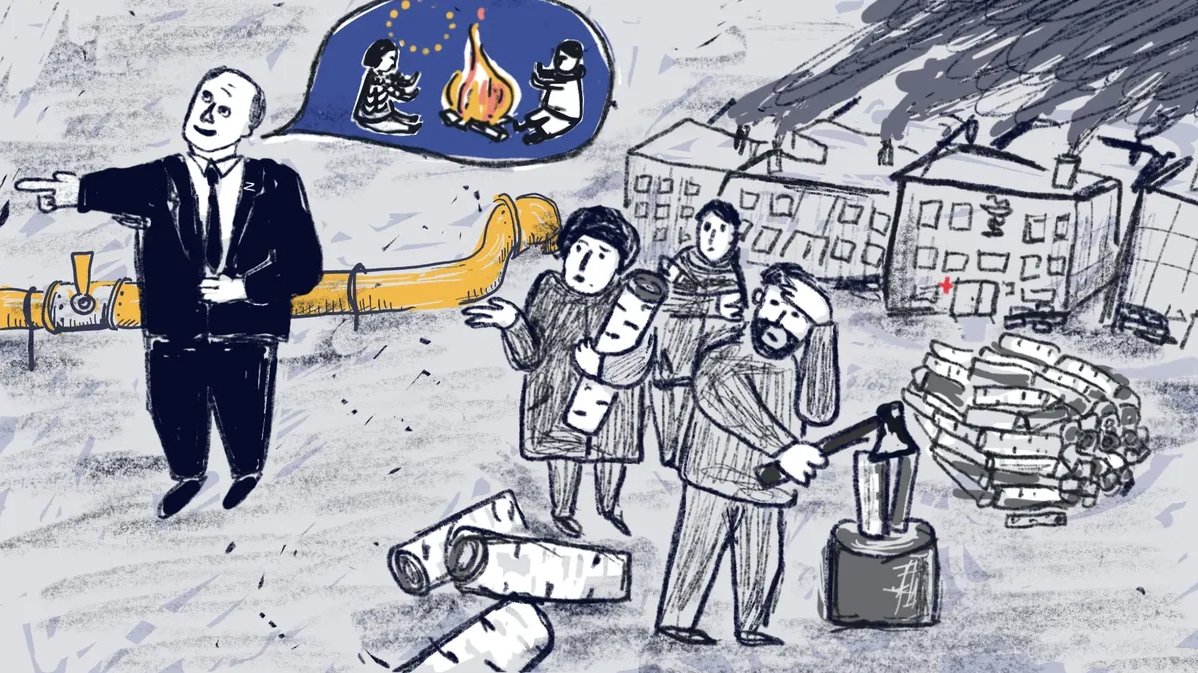Vladimir Putin and Alyaksandar Lukashenka troll Europeans who are forced to buy firewood due to the lack of Russia’s gas “like in the Middle Ages.” Both, however, seem to leave behind the fact that many Russia’s regions still use firewood for heating. The authorities spend over 3 billion rubles (€49,7 million) on firewood each year to heat state institutions, including schools and hospitals. That said, in Russia the price of firewood, compared to the average wage level, is higher than in Germany.

A health facility in Borodino, Moscow region. Photo: Yandex Maps
This wooden building is a rural hospital in Borodino, the Moscow region, a two-hour drive away from the Kremlin. Eight cubic metres of birch firewood were purchased in September 2022 to heat it.
The Mozhaysk Central District Hospital buys firewood for the Borodino hospital, same as for 4 other health facilities in the same district. It spent a total of 800,000 rubles (€13,000) on firewood this year.
“People have started to stock up firewood for the winter, just like in the Middle Ages,” Vladimir Putin said in surprise on 12 October during this year’s Russian Energy Week event. “The reason is not the special military operation in Ukraine and Donbas, absolutely not. This is the result of the poor energy policy that had been in place for years.”
Putin did not sympathise Russians, those were “ordinary Europeans” he spoke about.
Taking cue from Putin, Alyaksandar Lukashenka prepared some drollery regarding the energy crisis as he chopped some firewood for Europe.
Rossotrudnichestvo, Russia’s agency for cultural exchange abroad, launched a campaign called “From Russia with Warmth”, inviting Europeans to their branch offices, Russian Houses, to “warm themselves for a while, drink a cup of tea and charge their cell phones.”
Firewood empire
Putin’s words about the Middle Ages are not irony but post-irony for those who know that entire regions of Russia permanently use coal and firewood for heating.
Russia has already spent 3.6 billion rubles (€58.5 million) on firewood this year, and this figure is most likely to surpass 4 billion by the end of the year.
The most frequent buyers are boiler station operators: they use wood to heat up people’s homes, spending a total of 2.1 billion this year (€34.4 million). Second to them are various state institutions, such as farming enterprises or the Russian Railways, who spent almost 450 million (€7.4 million).
Firewood is still used in Russia to heat up schools, kindergartens, and even hospitals countrywide. For instance, the republican vets hospital in Buryatia, the region which is among those that lost most men in the Ukraine War, is heated by firewood, same as the city hospital in Irbit, the region of Yekaterinburg. Hospitals in the regions of Tver and Saint Petersburg, European Russia, use firewood, too.
Governments in Russia’s settlements, also buy firewood for their own needs and or provide it to locals. Moreover, people who live in houses heated by firewood have plots of woodland where they are allowed chop wood themselves, and low-income families receive monetary aid for buying wood.
Firewood is also being handed out to families where all men have been mobilised, up to 10 cubic metres of firewood per family. However, receiving those becomes challenging at times.
Dreams come cruel
Surprisingly, the residents of Berlin and Russia’s Ulan-Ude faced similar problems this autumn. The shutdown of the Nord Stream pipeline caused the price of firewood to rise by 86% in Germany this year. Russia’s Buryatia which never had gas infrastructure anyway suffered a price surge of “just” 25%.
Notably, firewood is much more affordable for Germans than for the residents of Buryatia. A cubic metre of firewood costs about 9,000 rubles (€150) in Germany. The average monthly salary there is €4,100, or 27 cubic metres of firewood. Buryatia’s firewood is way cheaper: 2,900 rubles (€47.5) per cubic metre, however, the average income there is 33,000 rubles (€540), enough to buy 11.5 cubic metres.
The official statistics say that 12% of Russia’s homes have no heating systems, i.e., are heated by firewood or electric heaters which are not considered heating systems. Almost half of residents in Russia’s Chita region and Buryatia use firewood to heat up their homes (45–46%), as well as one third of the population in the region of Arkhangelsk and the annexed city of Sevastopol.
Regions in Central Russia also have heating issues. There are no warm radiators in almost one third of housing in the regions of Veliky Novgorod, Tver, and Pskov (the official stats count living space, not the number of apartments).
In nine Russia’s regions, less than 5% of all households have gas supply
* Annexed by Russian Federation
Sources: PJSC Gazprom, media
Russia’s gas infrastructure expansion programme was launched in 2005. The plan was to supply each Russian village with gas in 10 years, until 2015.
The programme was extended to 2030 in 2019, the new proportion of settlements planned to be supplied with gas dropping from 100 to 85%. Novaya Gazeta gave an insight into why this happened and whether full gasification of the country was rational at all back in the day.
It needs to be noted that the programme bogged down drastically in 2008. Before 2007, the proportion of households with gas supply increased by an average 1.7% annually; from 2008 onwards, this number stands at around 0.7% each year.
One of the main reasons behind the low rates of gas infrastructure expansion was enabling Gazprom to have monopoly on Russia’s gas exports. It was planned that the gas giant would spend excess exports profit to connect distant settlements to the gas grid, but in reality, the money was invested into foreign infrastructure instead.
Gazprom’s export bonus was 2.1 trillion rubles (€34.27 billion) in the 2015-2020 period, but only one tenth of this amount was spent on Russia’s gas infrastructure expansion, about 209 billion (€3,41 billion), as per Vedomosti.
This means that Gazprom first constructed the Nord Stream pipelines, as well as the Blue Stream and TurkStream ones, at the expense of domestic consumers, and then, becoming a tool in the gas wars, lost its European market, too.
Will Europe freeze?
Russia’s gas supply to Europe finally became a tool in warfare since the start of the invasion of Ukraine. Russia started shutting off gas valves for Europe in 2021, before ultimately stopping the Nord Stream operation in August 2022. This caused its gas exports to the countries outside the former Soviet Union to decrease by 40% this year. Russia’s share of the European gas market collapsed from 40 to 7.5%.
The Eastern European countries, such as Romania, Hungary, Slovakia, Bulgaria, Croatia, as well as Germany are most dependent on Russia’s gas supply, not the Western European ones. These countries imported over 65% of its gas from Russia in 2020, heating more than a half of their households with it.
In these circumstances Europe started looking for an alternative to Russia’s supplies, and it did find one. The EU is now increasing its imports of liquefied natural gas. This commodity can be transported by fuel tankers. Russia is being replaced by the US and the UK. Great Britain imports the liquefied gas and then supplies it to the EU, using pipelines.
Moreover, the EU is rescheduling the closure of its nuclear power stations and is ramping up the production and usage of coal and firewood. The latter was commonly used for heating even before the Ukraine War, for instance, in Latvia and Hungary. However, the energy crisis forced even the middle-class Berlin residents to sweep their chimneys and to bring their old wood stoves into shape, preparing for potential heating supply issues.
Europe has managed to prepare for the upcoming winter overall thanks to reduced consumption and energy sources diversification. Germany’s gas reservoirs are 95% full, Italy’s ones are 93% full. The gas prices are spiralling downward.
Infographics by Artyom Shchenniko
Join us in rebuilding Novaya Gazeta Europe
The Russian government has banned independent media. We were forced to leave our country in order to keep doing our job, telling our readers about what is going on Russia, Ukraine and Europe.
We will continue fighting against warfare and dictatorship. We believe that freedom of speech is the most efficient antidote against tyranny. Support us financially to help us fight for peace and freedom.
By clicking the Support button, you agree to the processing of your personal data.
To cancel a regular donation, please write to [email protected]

